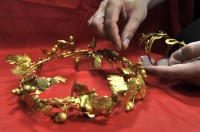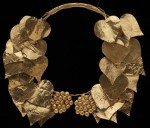 Highway police in the village of Asprovalta near Thessaloniki in Greece have arrested two men for attempting to sell an ancient gold wreath and armband. Authorities had been tipped off that one of the men, a house painter, was trafficking in antiquities, so they stopped his car outside Asprovalta and found the beautiful and precious artifacts in a shoebox under the passenger seat. Also in the car was a retired police officer who was detained along with the house painter on suspicion of smuggling antiquities.
Highway police in the village of Asprovalta near Thessaloniki in Greece have arrested two men for attempting to sell an ancient gold wreath and armband. Authorities had been tipped off that one of the men, a house painter, was trafficking in antiquities, so they stopped his car outside Asprovalta and found the beautiful and precious artifacts in a shoebox under the passenger seat. Also in the car was a retired police officer who was detained along with the house painter on suspicion of smuggling antiquities.
The wreath, made in the shape of oak leaves and acorns, weighs almost one kilo (2.2 pounds) which at current prices would be worth over $50,000 in gold weight alone. Add in the archaeological value and it’s priceless. The armband is in the shape of two interwoven snakes, decorated with red gemstones.
The painter, who had apparently been trying to sell the pieces for hundreds of thousands of euros, told police he had gotten the wreath and armband from someone in his hometown of Komotini, the capital of East Macedonia and Thrace, Greece’s easternmost region, but he claimed not to know where they were originally discovered. They could well have been looted from the Komotini area.
The wreath was a rare and valuable find, said Nikos Dimitriadis, head of the Thessaloniki police antiquities theft section.
“It is a product of an illegal excavation from a Macedonian grave, according to archaeologists (who examined it),” he said.
Many Macedonian graves have been discovered to contain elaborate gold artifacts, including gold wreaths. Wreaths were made in the shape of leaves — for example, oak, olive, laurel — associated with various deities. The oak leaves in the wreath in this news story were associated with Zeus who held the oak sacred.
 Gold wreaths have been found in the graves of the wealthy in the Hellenistic world from Macedonia to southern Italy to the Dardanelles starting in the fourth century B.C. Ancient sources report that gold wreaths were often used in religious ceremonies and donated to religious centers. The most famous and elaborate wreath was found in the Central Macedonia city of Vergina in the tomb of Philip II of Macedon, Alexander the Great’s father. It is made of 313 incredibly fine gold oak leaves and 68 acorns and weighs a total of 1.6 pounds.
Gold wreaths have been found in the graves of the wealthy in the Hellenistic world from Macedonia to southern Italy to the Dardanelles starting in the fourth century B.C. Ancient sources report that gold wreaths were often used in religious ceremonies and donated to religious centers. The most famous and elaborate wreath was found in the Central Macedonia city of Vergina in the tomb of Philip II of Macedon, Alexander the Great’s father. It is made of 313 incredibly fine gold oak leaves and 68 acorns and weighs a total of 1.6 pounds.
 The Archaeological Museum of Thessaloniki, just 25 miles west of where the looters were busted, hosts the world’s largest collection of Macedonian gold wreaths and other metalwork. A drawing of one them is the museum’s logo.
The Archaeological Museum of Thessaloniki, just 25 miles west of where the looters were busted, hosts the world’s largest collection of Macedonian gold wreaths and other metalwork. A drawing of one them is the museum’s logo.  In a coincidence that feels like a painful irony (see Alanis Morissette for more of those), there’s an exhibit at the museum right now entitled End to Antiquities Trafficking which features two Macedonian gold wreaths that were looted and later returned to Greece.
In a coincidence that feels like a painful irony (see Alanis Morissette for more of those), there’s an exhibit at the museum right now entitled End to Antiquities Trafficking which features two Macedonian gold wreaths that were looted and later returned to Greece.